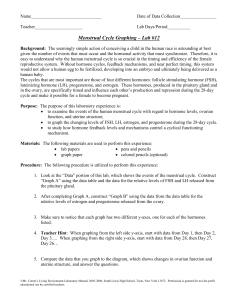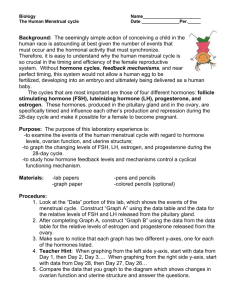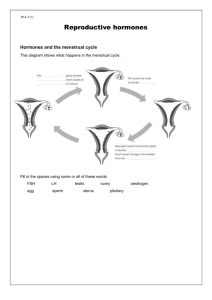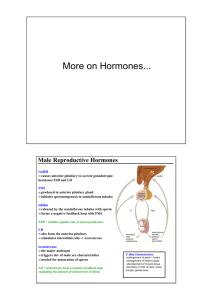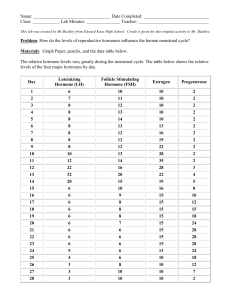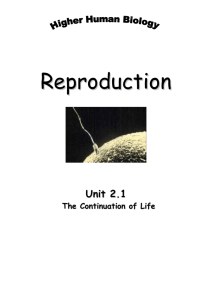Menstrual Cycle Graphing – Lab #12
advertisement
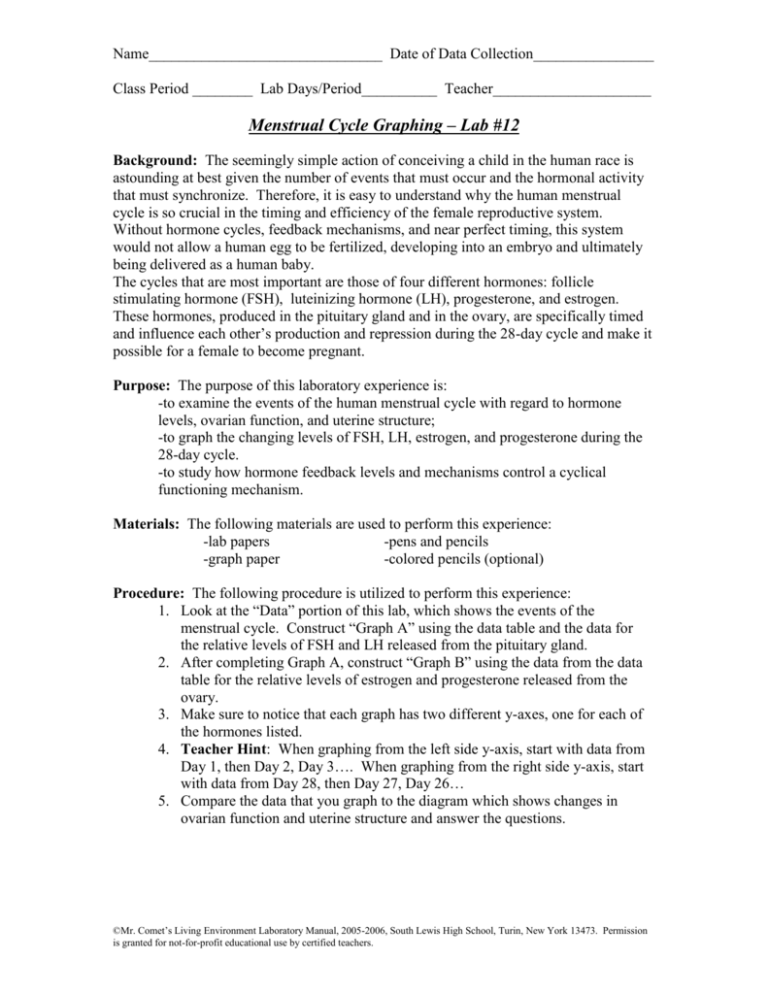
Name_______________________________ Date of Data Collection________________ Class Period ________ Lab Days/Period__________ Teacher_____________________ Menstrual Cycle Graphing – Lab #12 Background: The seemingly simple action of conceiving a child in the human race is astounding at best given the number of events that must occur and the hormonal activity that must synchronize. Therefore, it is easy to understand why the human menstrual cycle is so crucial in the timing and efficiency of the female reproductive system. Without hormone cycles, feedback mechanisms, and near perfect timing, this system would not allow a human egg to be fertilized, developing into an embryo and ultimately being delivered as a human baby. The cycles that are most important are those of four different hormones: follicle stimulating hormone (FSH), luteinizing hormone (LH), progesterone, and estrogen. These hormones, produced in the pituitary gland and in the ovary, are specifically timed and influence each other’s production and repression during the 28-day cycle and make it possible for a female to become pregnant. Purpose: The purpose of this laboratory experience is: -to examine the events of the human menstrual cycle with regard to hormone levels, ovarian function, and uterine structure; -to graph the changing levels of FSH, LH, estrogen, and progesterone during the 28-day cycle. -to study how hormone feedback levels and mechanisms control a cyclical functioning mechanism. Materials: The following materials are used to perform this experience: -lab papers -pens and pencils -graph paper -colored pencils (optional) Procedure: The following procedure is utilized to perform this experience: 1. Look at the “Data” portion of this lab, which shows the events of the menstrual cycle. Construct “Graph A” using the data table and the data for the relative levels of FSH and LH released from the pituitary gland. 2. After completing Graph A, construct “Graph B” using the data from the data table for the relative levels of estrogen and progesterone released from the ovary. 3. Make sure to notice that each graph has two different y-axes, one for each of the hormones listed. 4. Teacher Hint: When graphing from the left side y-axis, start with data from Day 1, then Day 2, Day 3…. When graphing from the right side y-axis, start with data from Day 28, then Day 27, Day 26… 5. Compare the data that you graph to the diagram which shows changes in ovarian function and uterine structure and answer the questions. ©Mr. Comet’s Living Environment Laboratory Manual, 2005-2006, South Lewis High School, Turin, New York 13473. Permission is granted for not-for-profit educational use by certified teachers. Name_______________________________ Date of Data Collection________________ Class Period ________ Lab Days/Period__________ Teacher_____________________ Concentration of Hormones in Blood: Luteal Phase Concentration of Hormones in Blood: Follicular Phase Data: The following data was collected and analyzed during this lab experience: Day 1 2 3 4 5 6 7 8 9 10 11 12 13 14 15 16 17 18 19 20 21 22 23 24 25 26 27 28 Concentrations of Hormones FSH Estrogen LH Progesterone 9 30 9 0.6 11 40 12 0.8 13 50 16 1.0 14 70 18 1.0 15 80 19 1.0 14 100 16 1.0 14 130 12 1.2 15 140 19 1.2 13 180 15 1.3 11 200 16 1.5 9 220 20 1.5 18 230 30 1.6 13 220 75 1.8 9 200 58 2.0 9 180 30 2.3 8 150 14 3.7 8 120 10 5.8 8 100 9 8.3 8 50 7 10.4 7 30 5 12.0 7 25 3 12.0 6 25 3 11.8 5 25 2 10.3 5 25 3 7.2 6 20 3 4.0 7 20 4 3.0 7 25 5 1.5 8 25 7 0.8 ©Mr. Comet’s Living Environment Laboratory Manual, 2005-2006, South Lewis High School, Turin, New York 13473. Permission is granted for not-for-profit educational use by certified teachers. Name_______________________________ Date of Data Collection________________ Class Period ________ Lab Days/Period__________ Teacher_____________________ LH Concentration (units/mL) 15 10 5 0 150 100 50 0 1 2 3 4 5 6 7 8 9 10 11 12 13 14 15 16 17 18 19 20 21 22 23 24 25 26 27 28 Day of Cycle 20 0 0 200 20 5 250 40 10 1 2 3 4 5 6 7 8 9 10 11 12 13 14 15 16 17 18 19 20 21 22 23 24 25 26 27 28 Day of Cycle 60 15 FSH Concentration (units/mL) 20 Graph A: Hormones From Pituitary Gland Graph B: Sex Hormones from Ovary Estrogen Concentration (units/mL) 80 ProgesteroneConcentration (units/mL) FSH Concentration (units/mL) ©Mr. Comet’s Living Environment Laboratory Manual, 2005-2006, South Lewis High School, Turin, New York 13473. Permission is granted for not-for-profit educational use by certified teachers. Name_______________________________ Date of Data Collection________________ Class Period ________ Lab Days/Period__________ Teacher_____________________ Conclusion: Write a well-balanced conclusion for this experience. ________________________________________________________________________ ________________________________________________________________________ ________________________________________________________________________ ________________________________________________________________________ ________________________________________________________________________ ________________________________________________________________________ ________________________________________________________________________ ________________________________________________________________________ ________________________________________________________________________ ________________________________________________________________________ Analysis Questions: Answer the following questions in the spaces provided. 1. On what day does FSH reach its’ maximum concentration? What is happening with regard to the ovary at this point and what is happening with regard to the menstrual cycle? _______________________________________________________________________________ _______________________________________________________________________________ _______________________________________________________________________________ 2. What happens to the follicle during the first 14 days that you plotted? _______________________________________________________________________________ _______________________________________________________________________________ _______________________________________________________________________________ 3. What happens in the ovary and in the blood stream in days 1-14 that bring about a change in the uterus? _______________________________________________________________________________ _______________________________________________________________________________ _______________________________________________________________________________ 4. On what day does LH reach its’ maximum concentration? What is happening with regard to the ovary at this point and what is happening with regard to the menstrual cycle? _______________________________________________________________________________ _______________________________________________________________________________ _______________________________________________________________________________ ©Mr. Comet’s Living Environment Laboratory Manual, 2005-2006, South Lewis High School, Turin, New York 13473. Permission is granted for not-for-profit educational use by certified teachers. Name_______________________________ Date of Data Collection________________ Class Period ________ Lab Days/Period__________ Teacher_____________________ 5. Why does the level of FSH decrease and remain at a relatively low level during days 15-28 of the cycle? _______________________________________________________________________________ _______________________________________________________________________________ _______________________________________________________________________________ 6. What signals the end of one cycle and the beginning of another? _______________________________________________________________________________ _______________________________________________________________________________ _______________________________________________________________________________ 7. Why are the interactions of hormones and tissues in the menstrual cycle considered to be feedback mechanisms? _______________________________________________________________________________ _______________________________________________________________________________ _______________________________________________________________________________ 8. What roles does progesterone play in the feedback mechanism? _______________________________________________________________________________ _______________________________________________________________________________ _______________________________________________________________________________ 9. What roles does estrogen play in the feedback mechanism? _______________________________________________________________________________ _______________________________________________________________________________ _______________________________________________________________________________ Bibliography of Images Used Endometrial Development: http://www.sw.org/sw/iwcontent/public/obgyn/en_us/images/obgyn_cycle.gif ©Mr. Comet’s Living Environment Laboratory Manual, 2005-2006, South Lewis High School, Turin, New York 13473. Permission is granted for not-for-profit educational use by certified teachers.
